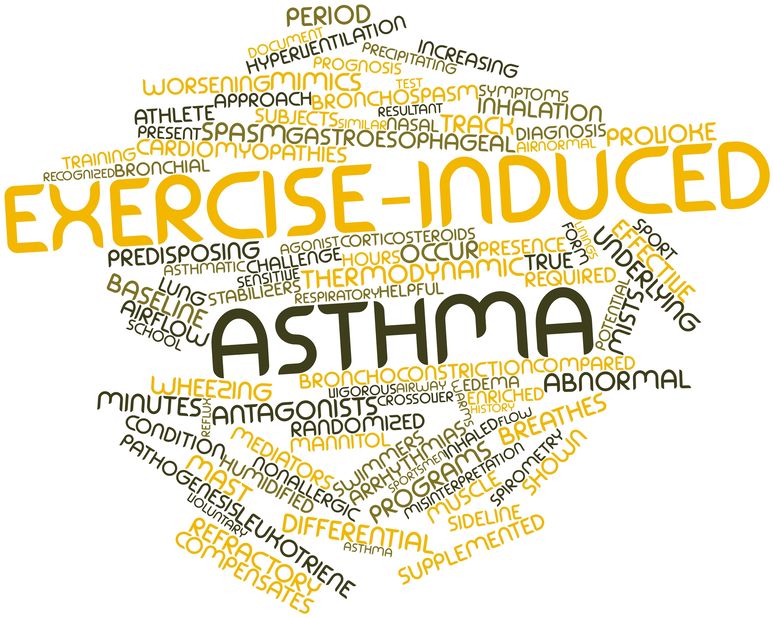
If we train our bodies to the point of failure, or just shy of that threshold, we typically find ourselves more than a bit winded. The feeling can be exhilarating! However, for clients with exercise-induced asthma, such a scenario tells a different story.
Making The Distinction
About 13% of our country’s population suffers with exercise-induced asthma, commonly referred to as EIA. “Exercise-induced asthma occurs in almost every individual diagnosed with chronic asthma, but there is a separate group of people who have what we call exercise-induced bronchospasm,” says Timothy J. Craig, MD, chair of the American Academy of Asthma, Allergy and Immunology’s Sports Medicine Committee.
For the average asthma sufferer, triggers such as a high pollen or mold count in the air set off the cascade of chest tightness and wheezing. This is due to many factors, but inflammation of the lung tissue is almost universally present. However, for individuals with EIA, as the name implies, asthma attacks come solely when participating in strenuous exercise.
Cold Concerns
At this time of year, as the mercury dips lower and lower, outdoor fitness and recreation activities can pose a significant challenge for our clients with EIA. A 2014 study conducted in China found that hospital admissions for asthma increased dramatically throughout the colder months.
In northern Finland, where temperatures dip into what we might call a frigid zone, as many as 82% of asthmatics experienced shortness of breath while trying to complete their typical outdoor exercises. Studies of winter Olympic athletes demonstrated that EIA affects up to 50% of these competitors, the highest rates correlating to cross-country skiers and competitive ski mountaineers.
If a client has been newly diagnosed with this condition, he may not be familiar with the proper precautions to take prior to running in cold weather. There are many ideas we can present to clients who do not wish to curtail their outdoor workouts but also strive to maximize the limits of their respiratory systems. Here, a bit of physiology goes a long way.
The Air Transport
The bitterly cold air inhaled by an outdoor winter runner reaches the lungs at a much warmer temperature, having been warmed to body temperature as it approaches the lower half of the trachea. From there, the inhaled breath gets 100% humidified prior to actually hitting the lungs.
Still, those with EIA must take extra precautions. The combination of cold air and aerobic activity such as running can create a “perfect storm”. Such a scenario not only exacerbates general asthma symptoms but also has the potential to ignite severe EIA symptoms.
Winter conditions can set off bronchial spasms, blocking incoming air from fully entering the lungs. Wheezing, coughing, a tight feeling in the chest, or shortness of breath soon follow (within 5-20 minutes after the start of physical exertion) and can turn into a serious asthma attack if not addressed promptly.
If you are joining your client on his outdoor winter workout, be on the lookout for these symptoms and be prepared to redirect the client, slowing your running pace and changing to walking as soon as possible. If the client’s symptoms do not subside upon reduction of intensity or total completion of the exercise, it may be wise to consult a physician. If he uses a rescue inhaler, this would be the time to suggest he use it.
How Trainers Can Help
We do not often associate very low temperatures with sweating, but this process occurs more than we realize. Reminding avid outdoor athletes to remain well-hydrated can stave off that undesirable burning sensation felt in the trachea during a brisk winter run.
It may seem like common knowledge for healthy athletes, but breathing is a very important component of any exercise, and even more so for those living with EIA. Proper breathing techniques exist and can be practiced by athletes with already compromised respiratory systems., to help ready them for extreme outdoor workouts. Training their bodies and minds to focus on slower, deeper breaths as opposed to taking shallow and quick breaths.
While inhaling through the nose, cold air must traverse a longer route prior to reaching the lungs. This air is therefore much warmer and better filtered than experienced by mouth breathers. This suggestion works well for outdoor runners who plan on relatively short excursions at a moderate pace.
However, as the intensity/duration/distance of the run increases, a nose breather will soon experience shortness of breath; it is not possible to provide the body with sufficient oxygen solely through average nose inhalations. This can pose a serious threat for those with EIA.
According to asthma specialist Dr. Rachel Taliercio, a good rule of thumb is to avoid outdoor exercise when temperatures dip into the single digits. When the mercury rises to the teens and above, a light warm-up is essential before breaking into an all-out run. At these temperatures, many runners find that covering both the mouth and nose with a light scarf helps the breathing process.
Having prudent, easy-to-follow suggestions for EIA clients who enjoy cold-weather workouts can empower them greatly, rather than simply regaling them with a list of potential pitfalls. Be smart, be safe, be successful!
References
health.clevelandclinic.org/cold-weather-can-give-you-exercise-induced-asthma/
fleetfeetcolumbus.com/training/mit-articles/got-a-burning-in-your-lungs-how-to-breath-in-the-cold-weather
www.webmd.com/asthma/features/athletes-guide-exercise-induced-asthma#1
www.livestrong.com/article/539775-running-in-cold-weather-lung-damage/
www.runtastic.com/blog/en/how-to-breathe-when-running-in-the-cold
journals.lww.com/acsm-csmr/fulltext/2006/12000/Exercise_induced_Asthma_in_the_Competitive_Cold.4.aspx
www.mensjournal.com/health-fitness/how-manage-exercise-induced-asthma-cold-weather/
www.healthline.com/health/asthma/cold-induced-asthma






